|
There are likely many ways to improve bunker
design to withstand the American bunker busters. In this file only a few
rudimentary thoughts are unfolded, but with the use of old concrete (flat)
blocks (from roads for example) and iron train rails you can come an end.
Anyway that is what I think.
The bunker buster is a weapon that is famous
because of the deep penetration it has in concrete, rocks and hard soil.
There are various numbers reported, for example 2 to 3 meters (yards) deep
in enforced concrete. Up to 100 feet in (hard) soil.
That is indeed a respectable weapon and when
used in combination with the Global Position System you can indeed achieve
devastating damage to bunkers. The art of countering this weapon is a
large scaling up of the latest armor as found on the American Stryker
vehicles.
In Iraq lots of so called Improvised
Explosive Devices (IDE's) are used against the freedom bringing forces of
America and the other coalition members.
Here is a picture of how that looks, you see not one big layer of steel
but lots of strips of metal to absorb the energy and shrapnel from the
blast:

Remark that this is far more efficient in use,
when all that metal had to be just one layer of metal you would need much
more metal. It is all about absorbing the energy.
And that is already the first answering in
effective bunker building, not one big layer of enforced concrete but many
layers made in cone shaped figures. (And soft soil in between these
layers.)
Why cone shaped?
That is to avoid constantly perpendicular
penetration of the bunker buster, that the bunker buster will change it's
course in the ground...
(That looks a bit like the next example: Suppose you have placed 10 pieces
of window glass after each other, all glass parallel to each other, and
under an angle of lets say 60 degrees you fire a bullet out of a gun. With
each window passing the bullet will change direction.)
An important technical detail of the bunker
buster is the use of depleted uranium in the nose, that very hard metal
can deliver the explosives so deep into the ground. This property can be
used to the advantage of new bunker design. Because the change of
direction under the ground is best achieved when perpendicular forces are
applied on the top of the penetrating device.
On a website named globalsecurity dot org you
can find many info upon American weapons, freedom of information is handy
in this case. Here is a pic as found on that website:

So that is how they look, for further
technical specifications look at the website mentioned above or use other
sources of information. Here is a photo that gives an idea of how it looks
in reality, the photo is rather different from the pic above but anyway:

Of course when building bunkers always local
terrain has to be taken in consideration, just like it is with normal
buildings. So suppose we are in a soft soil situation, as we have for
example here in Holland. (In a country like Iran it would be very
different of course.)
Beside concrete it might also be handy to weld
together lots of (old) train rails in some kind of metal curtain that will
lead away the penetrating bunker buster. So this too has to be applied in
cone like figures over the actual bunker.
What is the idea upon avoiding too much
attention from bunker busters?
Not that difficult;
- You dig a deep deep hole and start building
there the actual rooms for the bunker, the hull of the living &
working rooms are of course a rather big layer of enforced concrete
& metal.
- Then up to one meter of sand or clay or any
kind of soft soil that can absorb lots of energy.
- After that the first layer of (old) train
rails, nicely welded together to form some kind of curtain.
- Then soft soil again.
- Then concrete parts, flat and also so
placed that the bunker buster will be leaded away from the actual
bunker.
- And so on and so on, soft soil, train
rails, soft soil, concrete...
Ten to fifteen meters of these layers will
prove difficult for the penetrating bunker buster. The art of the design
lies it the fact that as much kinetic energy from the movement is used to
lead the weapon away from it's target.
At last the 'cone shaped' concrete and 'iron
curtains' can be used with the top up (for leading bunker busters away
from the actual bunker). Or they can be used with the top down to lead the
bunker busters towards tubes that will make the bunker buster explode far
away from the actual bunker. (Some kind of funnel for bunker busters.)
So it is far from impossible, just as the
design in the Stryker uses far less metal then just one hull of metal,
this principle can be used in building bunkers. May be it is long around
already, I do not know. Rumors go that the Yugoslavians are good bunker
builders, may be they use this a long time already. I just do not know,
all I know I had fun to write this down.
Hope you can lead a few American bunker
busters away ;)
Sincerely yours,
Reinko Venema.
| Update 01
(posted 07 October 2004). Today I realized another very cheap
way to hinder the penetration of bunker busters. Take into account
that these busters are especially designed to penetrate (enforced)
concrete, well have you ever axed wood?
Have you? And didn't it occur to you that most
wood is often easily penetrated by a sharp axe? But when you have
that triplex or multiplex wood where many small layers are
(perpendicular) glued
on each other, the axe only comes one or two millimeters deep in
it... No matter how hard you ram your axe into it, all kinetic
energy is absorbed efficient.
And that is the third material, a bunker buster
might be able to take a few meters of concrete but can a bunker
buster take 60 centimeters of multiplex?
Ha! What does that kind of stuff cost? With the
price of just a few bunker busters you can envelop a bunker in
multiplex kind of wood. Together with the materials named above
you can make cheap yet efficient bunkers that make military fools
of the Americans...
(Of course long lasting and enduring bombing
takes all protection away, but combined these materials together
with hollow tube like shapes can bring serious hinder to the
American military forces and their muppet armies like the Israeli
Defense Forces. Good luck Iranians...)
Update 02 (posted 18 October 2004). There
are also these plastic fibers that are much stronger then iron
fibers, suppose these fibers are woven into a (large) carpet. And
this carpet is just dropped on an irregular landscape (with some
boulders here and there, or some mountainous landscape).
Suppose there is one of those 'long hard rod
shaped' bunker busters coming in and it slams in on that fiber
mat. What would happen? (Experiments are important, the tip of the
impending rod has to be displaced a little bit so the whole
'penetration' breaks down.)
(Here in Holland where I live, when you order a
cubic meter of sand you get some cubic shaped 'plastic bag'
delivered it in. That kind of cheap stuff (but then a bit stronger
or in many layers) can do an amazing trick it you think upon
it...) And again: 'What does it cost?'
Update 03 (posted 15 November 2004).
Lately it was reported that the US military is considering a 30
thousand pound bunker buster. The sheer '30 thousand' number out
dwarfs stuff like daisy cutters (daisy cutters are no bunker
busters, they were used for example during the Vietnam war to
clear jungle for helicopter landings).
This looks very impressive but is it? Bombs that
big behave a lot like a balloon filled with water and there are
enough example from military history that indicate that bigger is
not necessary better. (Think for example on that giant cannon
named Fat Bertha during World War one, it was giant but it did not
work better...)
No, these 30 thousand pounders are very vulnerable
upon impact. Take large boulders that are a bit sphere like
shaped, most bunker busters will not hit the exact middle of the
boulder. When the nose of the bomb misses the exact middle, it
cannot be anything else then that the nose is pushed aside. A push
aside of 20 to 30 centimeters will do all the trick and the bomb
will start behaving like a balloon of water...
So just like eggs are placed in a carton, place
large sphere or egg like boulders into such an arrangement. When
the outside of the rocks is even polished and 'slippery' (for that
large bomb) it will even work better.
All in all armies must experiment themselves
too. Make dummy bombs with a coating of depleted uranium and
throw it from a plane from high altitude. (Armies that already
have cruise missiles themselves, like the Chinese army for
example, can use a modified version of that of
course.)
|
Title: Just
a little greeting card to the US bustered bunker busters.




Back
to Part 37
|



